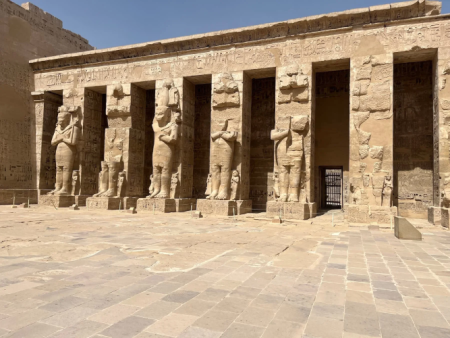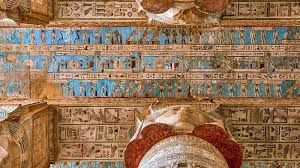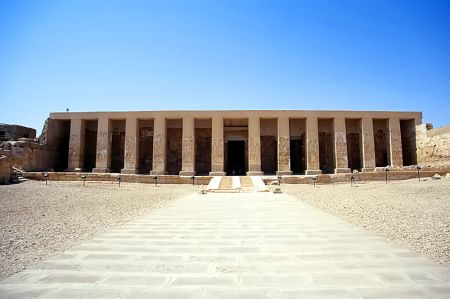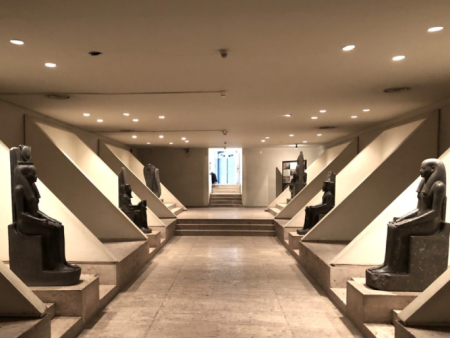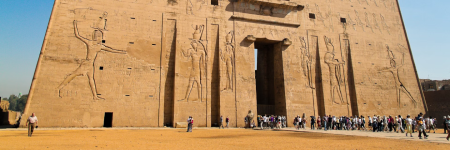Colossi of Memnon
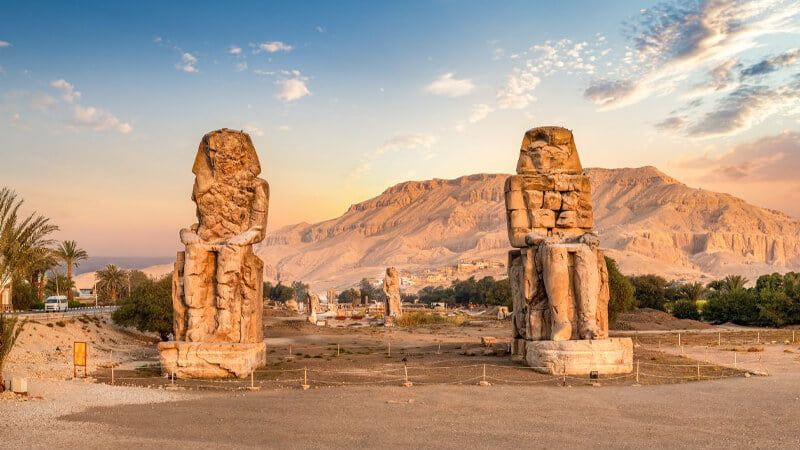
Colossi of Memnon: The Eternal Giants Guarding Ancient Thebes
Standing majestically on the western bank of the Nile River, the Colossi of Memnon are among the most awe-inspiring monuments of ancient Egypt. These two colossal statues, carved from single blocks of quartzite sandstone, once guarded the grand mortuary temple of Pharaoh Amenhotep III, one of ancient Egypt’s most powerful rulers. Rising about 18 meters high, the Colossi of Memnon are a timeless symbol of the might, artistry, and spirituality of the New Kingdom. Whether bathed in the golden glow of dawn or silhouetted against the fiery sunset over the Theban Necropolis, the statues evoke a sense of reverence that transcends time.
For travelers exploring Egypt Travel Packages, the Colossi of Memnon represent a gateway to the mysteries of Luxor’s west bank—a land that once thrived as the heart of Thebes, the capital of the ancient Egyptian empire. Surrounded by world-famous sites such as the Valley of the Kings, the Temple of Hatshepsut, and the Karnak Temple, these towering figures continue to attract travelers, scholars, and photographers from around the world. Their enigmatic presence, coupled with legends that echo through millennia, ensures that the Colossi of Memnon remain a cornerstone of Egypt’s cultural and archaeological legacy.
More than just architectural marvels, the Colossi of Memnon embody a fascinating blend of history, myth, and artistry. To the ancient Egyptians, they were divine sentinels watching over the pharaoh’s eternal journey. To the Greeks and Romans, they became the “singing statues,” famed for emitting mysterious sounds at dawn. Today, they stand as stoic reminders of Egypt’s golden age, where craftsmanship met divine purpose. Let’s delve into the story behind these iconic giants and uncover why they still captivate hearts thousands of years later.
The Origin of the Colossi of Memnon and Their Royal Patron
The Colossi of Memnon were constructed during the 18th Dynasty, around 1350 BCE, under the reign of Amenhotep III, one of Egypt’s most visionary pharaohs. Amenhotep III’s reign marked the pinnacle of prosperity, diplomacy, and cultural refinement. His grand mortuary temple, once the largest of its kind in Egypt, was designed not just as a place of worship but as an architectural declaration of divine kingship. The twin statues at its entrance symbolized the pharaoh’s eternal watch over both the living and the dead—guardians of the boundary between this world and the afterlife.
Each statue represents Amenhotep III seated on his throne, his hands resting on his knees, his gaze fixed eastward toward the rising sun and the life-giving Nile. Intricately carved on the sides are depictions of his mother, Mutemwiya, and his wife, Queen Tiye, testifying to the royal family’s divine lineage. The statues were quarried from a site near modern-day Cairo and transported over 675 kilometers to Thebes—a monumental engineering feat by ancient standards.
The Mortuary Temple of Amenhotep III and Its Lost Glory
Behind the Colossi once stood the Mortuary Temple of Amenhotep III, a complex so vast it dwarfed others in ancient Thebes. Unfortunately, centuries of Nile floods and earthquakes reduced the temple to ruins, leaving only the Colossi as silent witnesses to its former grandeur. What remains today is a tantalizing glimpse of what was once a masterpiece of architecture and devotion—a temple adorned with gold, precious stones, and stunning reliefs dedicated to the sun god Amun-Ra.
Modern archaeological missions continue to unearth fragments of the temple’s walls and statues, some of which now rest in the Luxor Museum. These findings help historians reconstruct the temple’s original splendor and deepen our understanding of Amenhotep III’s vision of eternity.
The Legend of the Singing Statues
In antiquity, the Colossi of Memnon gained worldwide fame not just for their size but for the mysterious sounds one of them emitted at dawn. After an earthquake in 27 BCE cracked the northern statue, it began producing a haunting melody as the morning sun warmed the stone. Ancient travelers described the sound as a soft whistle or hum, believed to be the voice of Memnon—a Trojan hero slain by Achilles and associated by the Greeks with the statue.
Roman emperors and travelers, including Emperor Hadrian, made pilgrimages to hear this “singing statue.” In 199 CE, Emperor Septimius Severus ordered restorations, which silenced the phenomenon forever. Scientists today believe the sound was caused by moisture trapped within the stone, expanding under the heat of sunrise. Yet, for centuries, people viewed it as a divine omen—a reminder that the statue was alive with the spirit of Egypt’s gods.
Memnon’s Connection to Greek Mythology
The Greeks, ever eager to intertwine their myths with foreign wonders, identified the northern statue as Memnon, the son of Eos, the goddess of dawn. According to legend, Eos wept for her fallen son each morning, and his voice answered her cries through the statue’s melody. Hence, the name “Colossi of Memnon” persisted, even though the statues originally depicted Pharaoh Amenhotep III. This merging of Egyptian and Greek lore transformed the site into a symbol of cross-cultural fascination that endures to this day.
Architectural Brilliance: The Artistry and Engineering of the Colossi
The Colossi of Memnon are marvels of ancient engineering. Each statue weighs about 720 tons, carved from quartzite blocks transported from quarries near Gebel el-Ahmar, east of Cairo. The craftsmen meticulously shaped every detail—from the royal headdress to the intricately carved throne sides featuring scenes of Nile gods binding together Upper and Lower Egypt. Despite millennia of erosion, the majestic symmetry and expression of calm authority remain remarkably intact.
Archaeologists note that the Colossi were originally painted in vibrant hues—reds, yellows, and blues—that have long since faded under the desert sun. The statues’ positioning was deliberate: facing eastward, they greeted the sunrise, symbolizing rebirth and divine illumination. This alignment underscores the ancient Egyptian belief in the cyclical nature of life, death, and resurrection.
Modern Preservation and Discoveries Around the Site
Ongoing restoration efforts by international teams have revealed dozens of statues, stelae, and temple fragments buried around the Colossi. Excavations led by archaeologist Dr. Hourig Sourouzian have uncovered colossal statues of Amenhotep III’s wife, Queen Tiye, and depictions of deities such as Sekhmet, the lioness goddess of war and healing. These discoveries reaffirm that the Colossi were just the tip of a monumental complex that once defined royal mortuary architecture in ancient Egypt.
Colossi of Memnon: A Journey Through Time and Myth
Visiting the Colossi of Memnon is like stepping into a living chronicle of Egypt’s glory. Every crack, every faded inscription whispers stories of ancient rituals, royal ambitions, and divine connections. The statues have witnessed countless epochs—from the rise of Thebes to the rule of Roman emperors, through centuries of silence to their rediscovery by modern-day explorers.
For travelers embarking on Egypt Nile Cruises or exploring Egypt Excursions, the site offers not just a photo opportunity but a profound connection to human creativity and endurance. The morning light paints the statues in golden tones, while the desert breeze whispers echoes of ancient hymns—a sensory experience that no camera can fully capture.
Best Time to Visit and Traveler Insights
The ideal time to visit the Colossi of Memnon is early morning or late afternoon when the sunlight enhances their grandeur. The site is easily accessible from Luxor City, making it a must-stop on any west bank itinerary alongside the Avenue of Sphinxes and the Habu Temple. For those seeking a deeper dive into ancient Egyptian civilization, local guides provide insightful narratives connecting the monuments to the broader tapestry of Egypt’s royal history.
FAQs About the Colossi of Memnon
What are the Colossi of Memnon made of?
The statues are carved from quartzite sandstone, transported from quarries near modern-day Cairo. Each block weighs hundreds of tons and was precisely aligned to face the rising sun, symbolizing rebirth.
Why are they called the Colossi of Memnon?
The name originates from Greek mythology. After an earthquake caused one statue to emit musical sounds, Greeks associated it with Memnon, the son of Eos, whose voice was thought to sing at dawn.
Can visitors still hear the “singing” sound today?
No, the mysterious sound ceased after Roman Emperor Septimius Severus repaired the cracked statue in the 2nd century CE. However, the legend remains one of Egypt’s most enchanting tales.
Where exactly are the Colossi of Memnon located?
They stand on the west bank of the Nile River near modern Luxor, close to the site of Amenhotep III’s mortuary temple. The area forms part of the Theban Necropolis, home to numerous tombs and temples.
What other attractions are near the Colossi of Memnon?
Nearby attractions include the Valley of the Queens, the Temple of Seti, and the Dandara Temple. Each site unveils another layer of the ancient world’s grandeur and artistic genius.





